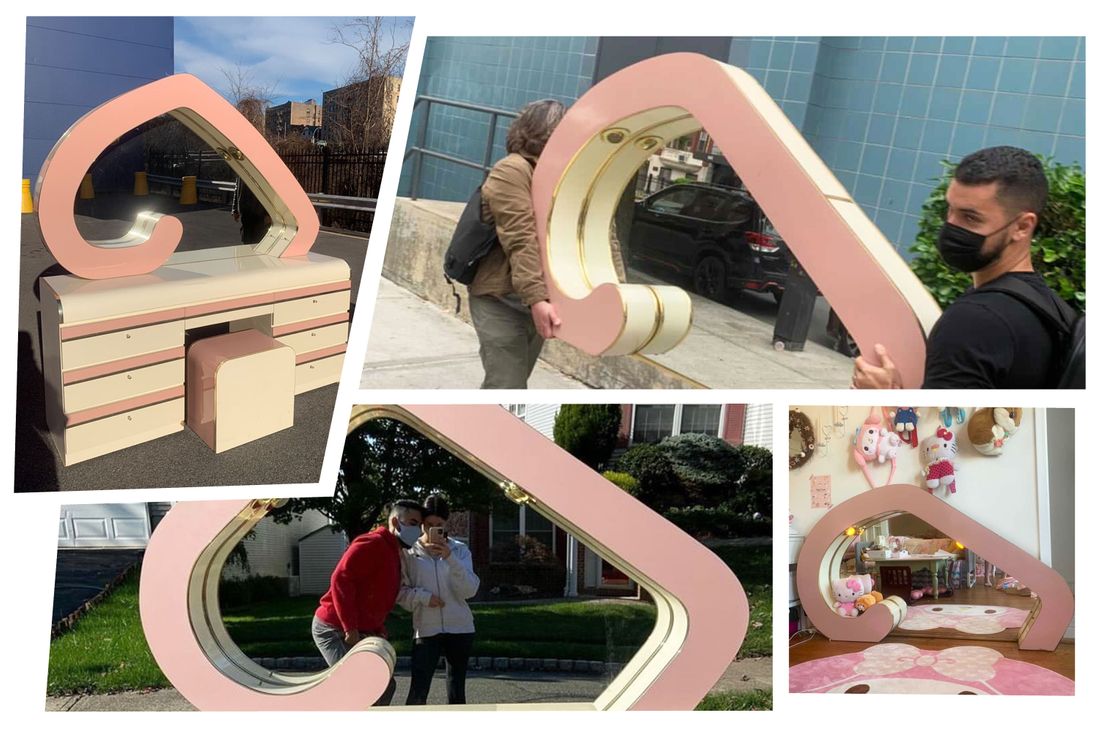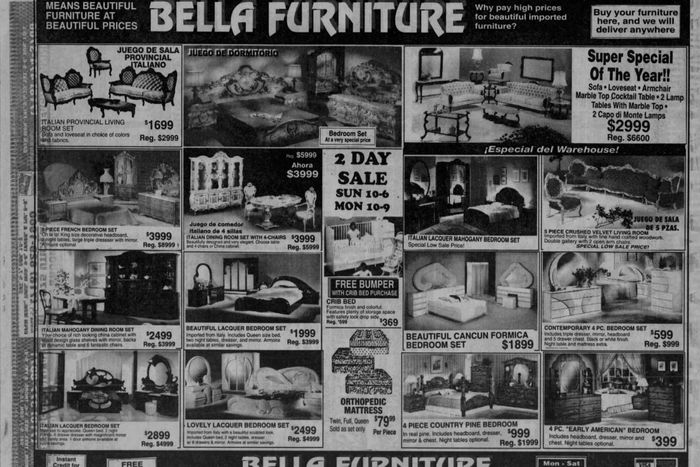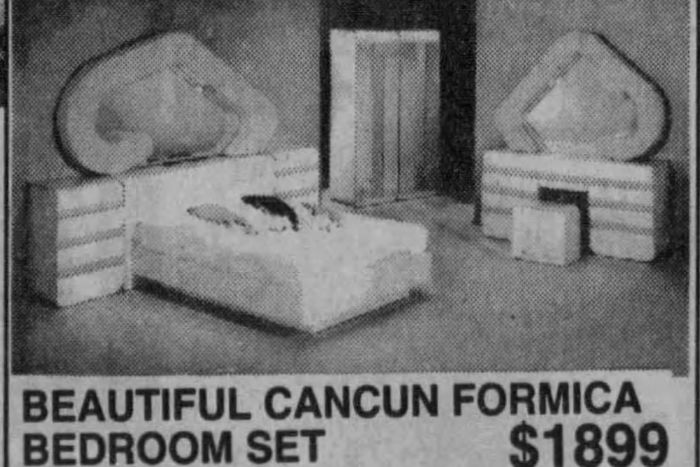
Last week, Sophie Kendall found a 1980s-style pink mirror shaped kind of like half of a heart, or maybe an ear, on a curb in Chelsea. She hauled it back to her apartment, where it fit right in with her Hello Kitty collectibles and bubblegum décor. She posted the story of how the campy mirror went from the curb to her living-room floor on her Instagram, and it quickly went viral after the account @StoopingNYC shared the saga on its page.
The comments flooded in. “My parents had this in their bedroom,” one person said. Lindsay Vrckovnik posted that she had found the same item in Bushwick on the very same day. And it turned out that a lot of other people had the same mirror, too. “This is crazier than all the metal sculptures that were popping up around the world,” one person commented. And, inevitably, there were haters: “Everyone has the same bad taste. Lovely.” Because it had built-in lights around the frame, there was some speculation that it might come from a barbershop or beauty salon.
In just a couple of days, posts about this mirror on @StoopingNYC received over 80,000 likes (and counting). “We’ve had a few things go viral in the time that we’ve run the account, but this is bananas,” one of Stooping’s admins told Curbed. “Seeing the same piece of furniture not just span the five boroughs but span generations was amazing and super-cool.” Stoopers have since started calling it the ear mirror, or “ear-ror.”
Along the way, the same questions kept arising: What is this thing? Where did it come from? There are no brand markings on the mirrors, and there are a couple of slight variations in the shape. As I saw the story unfold — from a few people sharing their stooping successes to others digging out old photos of their relatives’ bedrooms to full-on memes happening — I became invested in getting some answers. After a week of dead ends and conflicting information, what emerged was, in part, a story about how the business of furniture has shifted in the past 40 years.
As some commenters on the Stooping posts pointed out, the Brooklyn dealer Las Vibras Vintage has listed these mirrors in the past. It’s come across five of them at estate sales in the tristate area recently and has been selling them through its Instagram storefront. They’re part of a bedroom set that includes a vanity with a mirror and stool; a mirrored headboard with a built-in AM/FM clock-radio; two nightstands; and an armoire. When Las Vibras has listed the mirrors, “they’ve all sold instantly, and we have a wait list of followers asking us to find them one,” says Erica Canale, one of the dealer’s co-owners.
Curious about the origins herself, she asked the sellers if they remembered where they’d bought them. Some said the pieces had come from local furniture stores between the 1970s and 1990s, specializing in imported Italian furniture that was ordered via catalogue, but they didn’t remember names. The only two clues were the material — Canale thought it was lacquer-finished — and “Made in Italy” stickers on the mirrors. No other labels, brands, or marks were anywhere.
I thought, perhaps, that someone at one of those old retailers might remember it. Roma — the Lower East Side dealer where some of the furniture in GoodFellas came from — is still around on Long Island, so I started there. Jerry McCrystal, the current owner, speculated that if it was Italian and lacquer, it would be from John Turano & Sons, a manufacturer and distributor of Italian furniture. McCrystal didn’t work the sales floor back in the 1980s, though, and said he would send the photo to some old-timers who had.
I knew I needed some reinforcements, so I asked a friend who’s a really gifted thrifter whether she’d come across this mirror. She had, but not at an estate sale or vintage store; instead, she directed me to a Twitter thread from a few months back. (Implausibly, the StoopingNYC attention was the second time this thing had gone viral.) In January, Rae Occhipinti, an artist and vintage-furniture consultant based in New Jersey, bought one of the bedroom sets from its original owner in Pennsylvania.
Occhipinti hadn’t been looking for postmodern furniture, but something about this set drew her in. “The energy of the vanity and the mirror is insane, and I felt an attraction to it as soon as I saw it,” she says. “It has such a strong presence … I cover [the mirror] when I go to sleep at night and I will have wild dreams when I don’t.” She too had asked the owners where it came from. They couldn’t remember, either — at first. But she had to make a couple of trips to get the whole bedroom set, and when she went back to pick up the final piece, they’d come up with a name: Seaman’s.
Of course. Seaman’s was ubiquitous in the tristate area a generation ago. Founded by Julius Seaman in Brooklyn in the 1930s, the company sold to price-conscious, middle-class consumers. After Julius Seaman died, his son Morton Seaman, a Wharton grad, took over and scaled the company up, eventually opening more stores in New York, New Jersey, Philadelphia, and Akron. By the 1980s, Seaman’s was advertising constantly on television and in newspapers. Its “See Seaman’s first!” jingle is practically a cheat code for researching ’80s-furniture looks.
Part of scaling up also included changing the business model. In the 1980s, the company began to buy furniture in bulk at discount prices. Before that, it had been typical practice to buy individual pieces from manufacturers. The change allowed the company to sell cheaper packages and to deliver immediately. In 1981, Seaman’s did $44.1 million in sales; by 1987, it was at $224.8 million. It was around this time, too, that Seaman’s began sourcing overseas. By 1989, Seaman’s was the second-largest furniture retailer in the United States, with 31 stores mostly in and around New York, and it had been sold to the investment firm KKR. (In 1993, the shop reached perhaps its highest honor, being immortalized in “Electric Relaxation” on A Tribe Called Quest’s Midnight Marauders, in a verse where Phife talks about a post-hookup mess, which starts around 2:25 in the video below.) Mort and his son Jeffrey Seaman went on to found Rooms to Go, a furniture chain that’s become pretty successful in the Southeast. After their departure from Seaman’s, its business struggled, and in 2005 it merged with Levitz.
Steven Husák, an e-commerce executive who now lives in Sarasota, Florida, was a salesperson at Seaman’s in the 1980s and worked mostly in New Jersey, with a brief stint in Philadelphia. When I called him, he told me that he not only remembered this exact bedroom set — he remembers selling one to, of all people, the Mets and Phillies pitcher Tug McGraw.
“I had been a ballplayer and never made it far, but [Tug and I] knew each other,” Husák says. “He phoned me at the Seaman’s store in South Philly and said, ‘I need you to help me out, my daughter is angry at me.’ Tug was good at messing up. He was a lovable mess-up. And he said, ‘She’s going to come into the store. Give her whatever she wants.’”
Husák told me that the collection was called the Barbarella, by — here again! — John Turano & Sons. He recalls this set being one of the most expensive — and the most fragile. “Turano warehoused in North Jersey, and they wouldn’t let Seaman’s delivery people handle the furniture because lacquer scratched so easily,” Husák says. “The commission from it was a whopper — like $180, which was a lot of money at the time.”
This was such an oddly specific story that it seemed hard to discount. But it seemed slightly off. The pieces in the photographs looked like laminate, not lacquer, and they didn’t seem expensive. Husák offered the disclaimer that he’s about to turn 63 and his memory is a bit foggy. I’d need some confirmation from a Turano & Sons employee.
John Turano & Sons is mostly gone, apart from a lonely “R” on a sign where it once had a factory in Red Hook. The vintage furniture attributed to the company is much more rococo than pomo — it really doesn’t look like this pink bedroom set at all. Turano — founded by Giacomo Turano, a Sicilian immigrant — imported Italian furniture but also manufactured some pieces Stateside. (When a chunk of steel fell at Yankee Stadium in 1998, it was onto a seat that Turano had season tickets for; a conspiracy theory at the time was that someone was out to get him.) Eventually, the trail led me to Steve Casa, a 44-year Turano employee who’s now the owner of Vesta Furniture in Bensonhurst. In his time there, he saw the company move from making furniture to distributing as labor costs rose. Seaman’s was its biggest customer for many years. The business closed after the euro was introduced and importing from Italy grew more expensive than customers were willing to pay. Surely if anyone at Turano would recognize the piece, it would be Steve. I texted him a few photos. My heart sank when he said he’d never seen the vanity or mirror before. Maybe Tug McGraw had bought something at Seaman’s, but it wasn’t a Turano & Sons piece.
Just when I thought I’d hit a dead end, I heard back from Jerry McCrystal. “So I was able to track down the sales rep who sold it back in the day,” he texted me. “He remembers the name of the collection. It was Cancun, believe it or not. He can’t remember the name of the company he got it from, but it was made down in Miami.”
Florida, not Italy. It’s something that made sense, what with Miami Deco style and all, but this went against some of the earlier information I received, like those Made in Italy stickers. I asked if anybody had old catalogues or other documentation around: “No one is going to have that,” McCrystal replied. “I sent [the picture] to a few guys and they all said the same thing: It came out of a Florida mica company and probably more than one [manufacturer] made it.” So it was probably Formica, not lacquer, after all. And indeed, the seller of a similar (though not identical) eBay listing, with a mirror that looks more like a heart than an ear, told me her parents had bought it in 1983 “at El Dorado Furniture in Miami.”
Then came the big break. Another vintage seller I follow, Vintage Furnish, posted the bedroom set. I asked about its background, and Nancy Zhong, the co-owner, had a little more information “They are laminate and unfortunately, we couldn’t find a maker’s mark … just some old dirty socks lost in the vanity. There was some writing in Spanish within the vanity, though.” She sent a photo. It was a handwritten scribble, and I couldn’t make most of the words out except one: CANCUN.
Which led to some new searches, and in an advertisement in a back issue of the New York Daily News, there it was.


In 1994, Bella Furniture in Ozone Park sold the full set for $1,899. It turned out Seaman’s wasn’t the only store in the New York area that had it. (The two slightly different shapes atop the headboard and the vanity explained why the mirrors on Instagram didn’t all match one another precisely.) Mirela Mujovic recognized the mirror on the StoopingNYC account as the one she had in her family home growing up. Her parents had bought a black-and-white bedroom for $1,400 from a mom-and-pop shop on Fordham Road in the Bronx.
Still hoping to find a manufacturer, I looked for laminate-furniture businesses in the Florida area and called Wholesale Mica and Furniture, which has been in business since 1978. “It’s all history now,” Ty Khaleel, the owner, told me. “All those factories are out of business. The owners either retired, passed, or moved on.” He explained that there once were a lot of laminate-furniture makers in the Miami-Dade area. Most were Latin-owned and -operated, and most were small. “Those businesses used to market to south Florida, but there were also one or two progressive ones that sent truckloads of furniture to New York to stores and retailers,” he told me. “I do remember seeing the set with an off-center half-heart, but there aren’t [new] mica bedroom sets because labor is expensive and mica is not cheap. An importer from China can do it for half the cost.” Khaleel no longer offers regular bedroom furniture for that reason. His company now sells Murphy beds and other space-savers.
That’s where the road ends, with a name — Cancun — and a few retailers, but no manufacturer or designer. And it’s not completely airtight: Maybe there was another company making these in Italy, which would explain that sticker on the back of one mirror. Perhaps someone reading this story might know a person who’s connected to one of those defunct furniture makers in Florida. But honestly, the very anonymity of this piece is partly what I like about it.
“At the end of the day, even if you don’t realize it at the moment, you have an emotional connection to furniture,” one of the StoopingNYC admins remarked to me. “You have fond memories from childhood. It’s that one piece that sets your home apart. That’s why people are connecting with this story. The collective bond is bringing this furniture a second life.” And that bond is about appreciating the piece for what it is — no pedigree or designer brand name needed. Some anonymous person in Miami with a laminate trimmer may have managed to do what Charles and Ray Eames or Ettorre Sottsass worked their whole lives to carry off.





